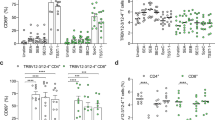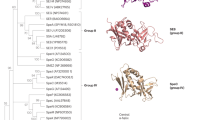Abstract
The current study investigated the effect of tetrachlorodibenzo-p-dioxin (TCDD) on the ability of staphylococcal enterotoxin A (SEA)-primed T cells to divide by dual-labeling the cells with 5,6–carboxyfluorescein diacetate succinimidyl ester (CFSE) and antibodies against the specific T cell receptors. C57BL/6 wild-type mice were injected ip with TCDD (10 μg/kg body weight) followed by hind footpad injections of SEA (10 μg/footpad). The draining popliteal lymph nodes (PLN) were harvested 1–4 days posttreatment, labeled with CFSE and cultured for 1–4 days without further stimulation or in the presence of the recall antigen. TCDD-exposed SEA-reactive Vβ3+ and Vβ11+ T cells showed decreased cell divisions upon in vitro culture in the absence of any stimulation, which correlated with increased levels of apoptosis. The recall cell-division response was also defective in SEA-reactive T cells isolated from TCDD-exposed mice. However, during the recall response, cells from TCDD-exposed mice did not exhibit a defect in apoptosis, suggesting the defective recall response may result from a state of anergy rather than increased apoptosis. Using AhR knockout (KO) mice, we found AhR involvement in the regulation of defective cell division and apoptosis induced by TCDD. Together, these data demonstrate, while TCDD-induced apoptosis may account for the decreased primary T cell proliferative response, that the reduced cell division seen during subsequent exposure to recall antigen may result from a state of anergy. The study also demonstrates that a combined use of superantigen and CFSE may offer a simple and useful tool to monitor the ability of immunotoxicants to alter the proliferative responsiveness of antigen-specific T cells.







Similar content being viewed by others
References
Camacho IA, Hassuneh MR, Nagarkatti M, Nagarkatti PS (2001) Enhanced activation-induced cell death as a mechanism of 2,3,7,8-tetrachlorodibenzo-p-dioxin (TCDD)-induced immunotoxicity in peripheral T cells. Toxicology 165:51–63
Camacho IA, Nagarkatti M, Nagarkatti PS (2002) 2,3,7,8-Tetrachlorodibenzo-p-dioxin (TCDD) induces Fas-dependent activation-induced cell death in superantigen-primed T cells. Arch Toxicol 76:570–580
Comment CE, Blaylock BL, Germolec DR, Pollock PL, Kouchi Y, Brown HW, Rosenthal GJ Luster MI (1992) Thymocyte injury after in vitro chemical exposure: potential mechanisms for thymic atrophy. J Pharmacol Exp Ther 262:1267–1273
Dearstyne EA, Kerkvliet NI (2002) Mechanism of 2,3,7,8-tetrachlorodibenzo-p-dioxin (TCDD)-induced decrease in anti-CD3-activated CD4(+) T cells: the roles of apoptosis, Fas, and TNF. Toxicology 170:139–151
Dohlsten M, Bjorklund M, Sundstedt A, Hedlund G, Samson D, Kalland T (1993) Immunopharmacology of the superantigen staphylococcal enterotoxin A in T-cell receptor V beta 3 transgenic mice. Immunology 79:520–527
Dooley RK, Morris DL, Holsapple MP (1990) Elucidation of cellular targets responsible for tetrachlorodibenzo-p-dioxin (TCDD)-induced suppression of antibody responses: II The role of the T-lymphocyte. Immunopharmacology 19:47–58
Givan AL, Fisher JL, Waugh M, Ernstoff MS, Wallace PK (1999) A flow cytometric method to estimate the precursor frequencies of cells proliferating in response to specific antigens. J Immunol Methods 230:99–112
Humphreys NE, Dearman RJ, Kimber I (2003) Assessment of cumulative allergen-activated lymph node cell proliferation using flow cytometry. Toxicol Sci 73:80–89
Kamath AB, Camacho I, Nagarkatti PS, Nagarkatti M (1999) Role of Fas-Fas ligand interactions in 2,3,7,8-tetrachlorodibenzo-p-dioxin (TCDD)-induced immunotoxicity: increased resistance of thymocytes from Fas-deficient (lpr) and Fas ligand-defective (gld) mice to TCDD-induced toxicity. Toxicol Appl Pharmacol 160:141–155
Kamath AB, Nagarkatti PS, Nagarkatti M (1998) Characterization of phenotypic alterations induced by 2,3,7,8-tetrachlorodibenzo-p-dioxin on thymocytes in vivo and its effect on apoptosis. Toxicol Appl Pharmacol 150:117–124
Kamath AB, Xu H, Nagarkatti PS, Nagarkatti M (1997) Evidence for the induction of apoptosis in thymocytes by 2,3,7,8-tetrachlorodibenzo-p-dioxin in vivo. Toxicol Appl Pharmacol 142:367–377
Kerkvliet NI (1995) Immunological effects of chlorinated dibenzo-p-dioxins. Environ Health Perspect 103(Suppl 9):47–53
Kerkvliet NI (2002) Recent advances in understanding the mechanisms of TCDD immunotoxicity. Int Immunopharmacol 2:277–291
Lawrence BP, Vorderstrasse BA (2004) Activation of the aryl hydrocarbon receptor diminishes the memory response to homotypic influenza virus infection but does not impair host resistance. Toxicol Sci 79:304–314
Lundberg K, Dencker L, Gronvik KO (1992) 2,3,7,8-Tetrachlorodibenzo-p-dioxin (TCDD) inhibits the activation of antigen-specific T-cells in mice. Int J Immunopharmacol 14:699–705
Lundberg K, Gronvik KO, Dencker L (1991) 2,3,7,8-Tetrachlorodibenzo-p-dioxin (TCDD) induced suppression of the local immune response. Int J Immunopharmacol 13:357–368
Lyons AB (1999) Divided we stand: tracking cell proliferation with carboxyfluorescein diacetate succinimidyl ester. Immunol Cell Biol 77:509–515
Marrack P, Kappler J (1990) The staphylococcal enterotoxins and their relatives. Science 248:705–711
Mitchell KA, Lawrence BP (2003) T cell receptor transgenic mice provide novel insights into understanding cellular targets of TCDD: suppression of antibody production, but not the response of CD8(+) T cells, during infection with influenza virus. Toxicol Appl Pharmacol 192:275–286
Parish CR (1999) Fluorescent dyes for lymphocyte migration and proliferation studies. Immunol Cell Biol 77:499–508
Pryputniewicz SJ, Nagarkatti M, Nagarkatti PS (1998) Differential induction of apoptosis in activated and resting T cells by 2,3,7,8-tetrachlorodibenzo-p-dioxin (TCDD) and its repercussion on T cell responsiveness. Toxicology 129:211–226
Rhile MJ, Nagarkatti M, Nagarkatti PS (1996) Role of Fas apoptosis and MHC genes in 2,3,7,8-tetrachlorodibenzo-p-dioxin (TCDD)-induced immunotoxicity of T cells. Toxicology 110:153–167
Schmidt JV, Bradfield CA (1996) Ah receptor signaling pathways. Annu Rev Cell Dev Biol 12:55–89
Takimoto H, Yoshikai Y, Kishihara K, Matsuzaki G, Kuga H, Otani T, Nomoto K (1990) Stimulation of all T cells bearing V beta 1, V beta 3, V beta 11 and V beta 12 by staphylococcal enterotoxin A. Eur J Immunol 20:617–621
Acknowledgements
This work was supported in part by grants by National Institutes of Health grants R01ES09098, R01AI053703-02, R01AI058300, R01DA016545 and R01HL058641.
Author information
Authors and Affiliations
Corresponding author
Rights and permissions
About this article
Cite this article
Faulconer, L., Camacho, I., Nagarkatti, M. et al. Superantigen-primed T cells exposed to 2,3,7,8–tetrachlorodibenzo-p-dioxin (TCDD) replicate poorly following recall encounter. Arch Toxicol 80, 134–145 (2006). https://doi.org/10.1007/s00204-005-0024-6
Received:
Accepted:
Published:
Issue Date:
DOI: https://doi.org/10.1007/s00204-005-0024-6




